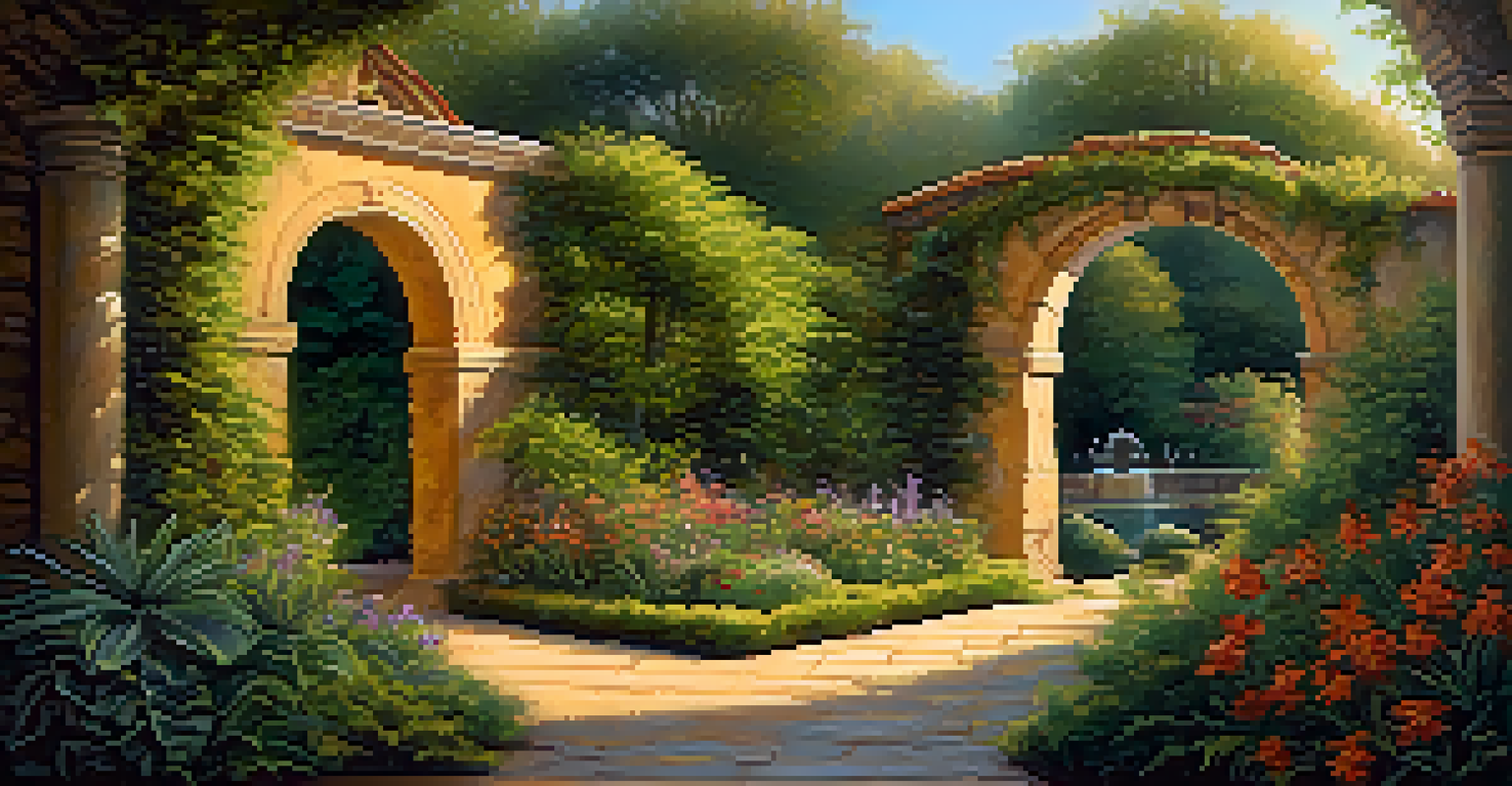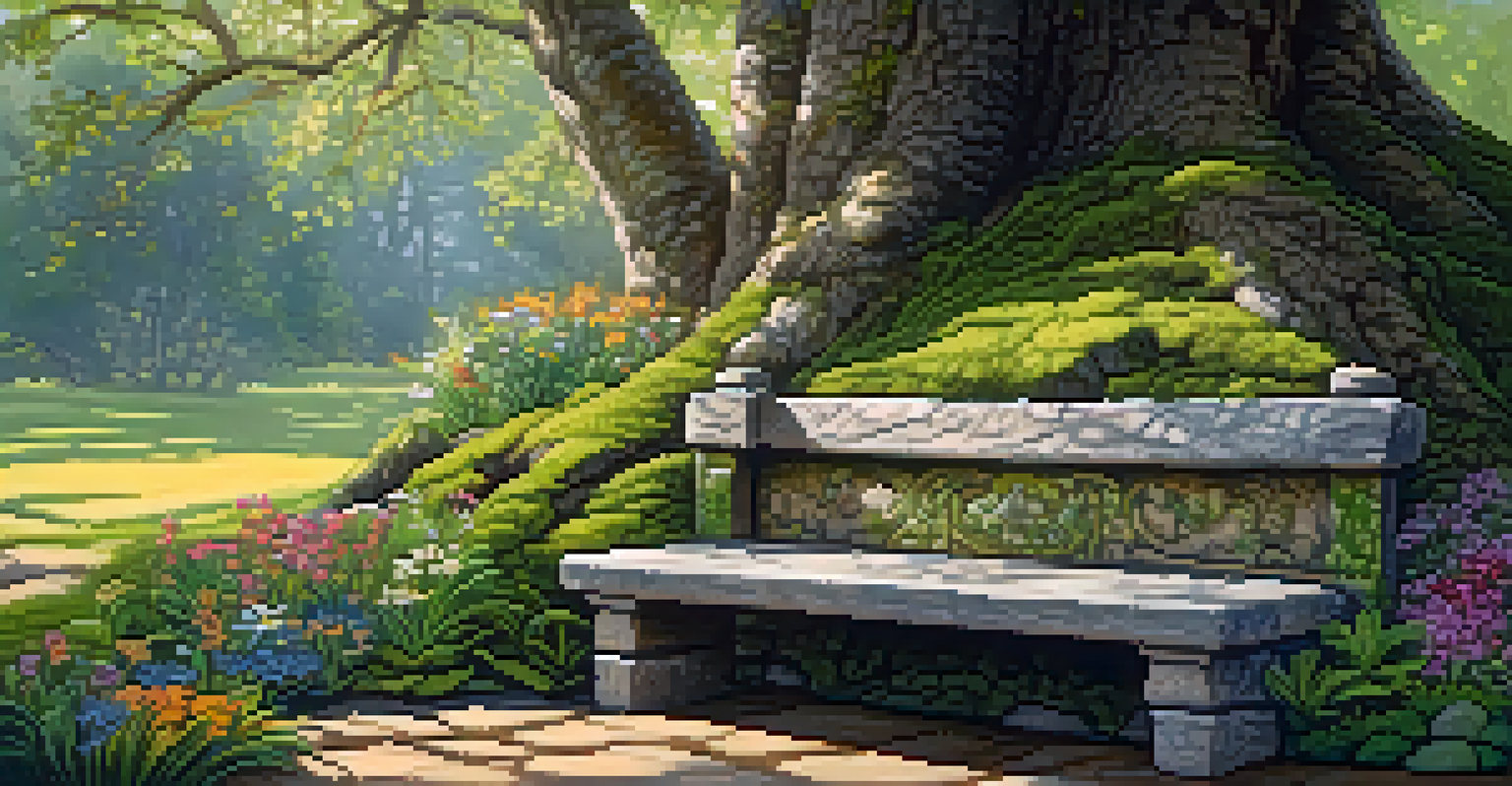Creating Focal Points with Carved Elements in Gardens

Understanding Focal Points in Garden Design
Focal points are essential in garden design as they draw the eye and anchor the space. Think of them like the main act in a play, capturing attention and creating a narrative. A well-placed focal point can transform an ordinary garden into a captivating landscape, inviting exploration and admiration.
Gardening is the purest of human pleasures.
Incorporating carved elements, such as sculptures or decorative stones, can elevate these focal points. These artistic pieces not only serve as visual anchors but also reflect the gardener's personality and style. Imagine walking through a garden and being greeted by a stunning, intricately carved statue that tells a story.
Ultimately, understanding and designing effective focal points is about creating a harmonious balance. Carved elements can serve to enhance natural beauty, integrate with surrounding plants, and create a cohesive narrative throughout your garden, making it a delightful experience for visitors.
Choosing the Right Carved Elements for Your Garden
When selecting carved elements, consider your garden's theme and style. Whether you prefer classical, modern, or rustic designs, the right piece can enhance the overall aesthetic. For instance, a sleek, modern sculpture may complement a contemporary garden, while a weathered stone bench could fit perfectly in a cottage-style setting.

Size and scale matter too; a large statue can dominate a small garden, while tiny carvings may get lost in a vast landscape. Aim for a balance that allows each piece to shine without overwhelming the surrounding flora. Remember, the goal is to create a dialogue between the carved elements and the natural surroundings.
Focal Points Enhance Garden Design
Strategically placed focal points draw the eye and create a captivating narrative in your garden.
Lastly, consider the materials used in your carved elements. Stone, wood, and metal each offer unique textures and colors, influencing the garden's ambiance. A beautifully carved wooden totem may evoke warmth, while a sleek marble piece can add a touch of elegance.
Placement Strategies for Carved Garden Elements
Placement is crucial when integrating carved elements into your garden design. Positioning them in areas where they can be naturally viewed creates a seamless experience. For instance, placing a carved birdbath near a seating area invites guests to pause and enjoy the view while also attracting local wildlife.
Nature does not hurry, yet everything is accomplished.
Consider the flow of movement throughout your garden. Strategic placement of carved elements can guide visitors along pathways, encouraging them to explore various sections. Imagine walking along a winding path, only to encounter a beautifully carved archway that beckons you into a hidden nook filled with flowers.
Additionally, think about the backdrop for your focal point. A carved element against a lush green backdrop or a vibrant flowerbed can create a stunning contrast, enhancing its visibility. This thoughtful placement allows the carved piece to stand out, making it a true centerpiece of your garden.
Incorporating Color and Texture with Carved Elements
Carved elements not only offer visual interest but also provide an opportunity to introduce color and texture into your garden. For example, a vibrant, painted wooden carving can serve as a cheerful focal point amidst softer, more muted plant colors. This contrast can bring a lively energy to the space.
Texture also plays a vital role in enhancing the overall garden experience. A rough-hewn stone sculpture can add a tactile element that contrasts beautifully with smooth leaves and delicate flowers. Consider how the surfaces of your carved elements interact with the surrounding plant materials.
Choosing the Right Carved Elements
Selecting carved elements that match your garden's theme and scale can elevate the overall aesthetic.
By thoughtfully selecting and positioning carved elements, you can create a rich tapestry of colors and textures that engage the senses. This dynamic interplay invites visitors to not only look but also feel the environment, deepening their connection to the garden.
Maintaining Your Carved Garden Elements
Maintenance is key to keeping your carved elements looking their best. Depending on the material, regular cleaning and protective treatments may be necessary to prevent weathering. For instance, wooden carvings might require periodic sealing to shield them from moisture and insects.
Regular inspections are also essential to catch any signs of damage early. A small crack in a stone sculpture can be easily repaired if addressed promptly, while neglecting it could lead to larger issues down the line. Staying proactive will ensure your focal points remain beautiful and intact.
Lastly, consider seasonal adjustments. Some carved elements may benefit from seasonal decor changes, such as adding festive decorations during holidays. This not only keeps your garden fresh and exciting but also allows for personal expression throughout the year.
Creating a Theme with Carved Elements
Establishing a theme can unify your garden and make it feel more cohesive. Carved elements provide an excellent opportunity to reinforce this theme, whether it’s a fairy-tale garden with whimsical sculptures or a Zen garden with minimalist stone carvings. Each piece can reflect the overarching story you wish to tell.
For example, if you’re aiming for a nature-inspired theme, consider incorporating carvings that depict flora and fauna. This not only enhances the visual appeal but also deepens the connection between the carved elements and the living plants around them. Imagine a beautifully carved owl perched on a stone, watching over a vibrant flowerbed.
Maintain Carved Elements for Longevity
Regular maintenance and seasonal adjustments are essential to keep your carved features looking their best.
Moreover, a consistent theme can also guide visitors through the garden. As they move from one area to another, the carved elements can serve as visual cues that enhance their experience, encouraging them to pause and appreciate each unique aspect of the garden.
Inspiration from Nature: Carved Elements in Gardens
Nature itself can be the greatest source of inspiration when it comes to carved elements in gardens. Look around at the shapes, patterns, and textures found in natural surroundings. Many sculptors take cues from organic forms, creating pieces that resonate with the environment, such as a carved leaf that mimics the real thing.
Incorporating natural themes into your carvings can create a sense of harmony within your garden. For instance, a sculpture of a tree trunk can blend seamlessly with real trees, adding an enchanting touch. This connection to nature not only beautifies the space but also fosters a feeling of tranquility.

Lastly, don't hesitate to explore the local art scene for unique carved elements. Many artisans create pieces inspired by the local flora and fauna, resulting in one-of-a-kind additions to your garden. Supporting local artists not only enriches your garden but also strengthens community ties.